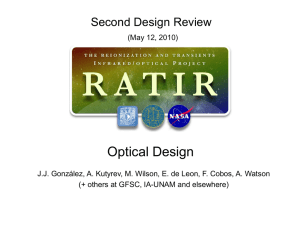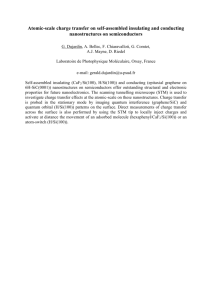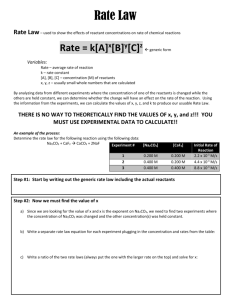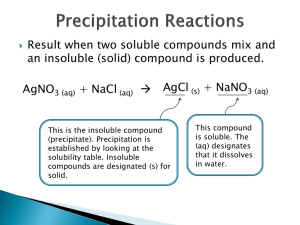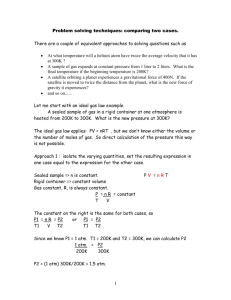11:15 AM - WFU Physics
advertisement
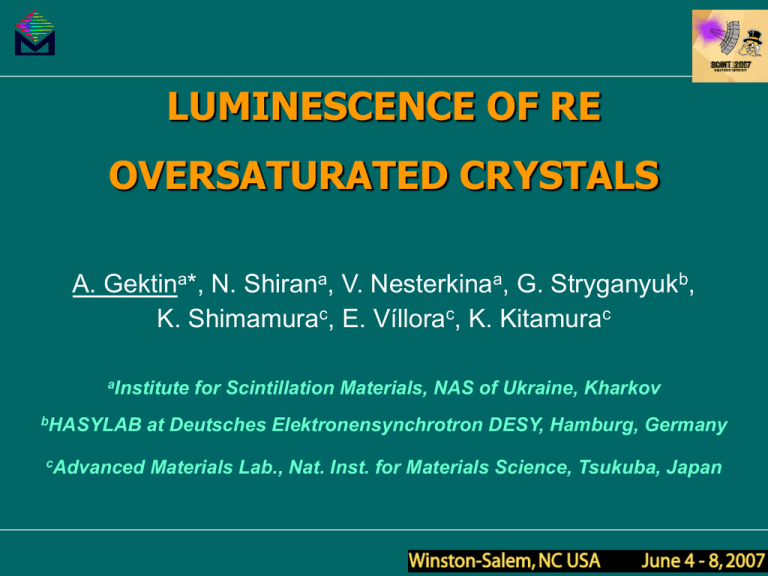
LUMINESCENCE OF RE
OVERSATURATED CRYSTALS
A. Gektina*, N. Shirana, V. Nesterkinaa, G. Stryganyukb,
K. Shimamurac, E. Víllorac, K. Kitamurac
aInstitute
bHASYLAB
cAdvanced
for Scintillation Materials, NAS of Ukraine, Kharkov
at Deutsches Elektronensynchrotron DESY, Hamburg, Germany
Materials Lab., Nat. Inst. for Materials Science, Tsukuba, Japan
Motivation
Fluorides allows to modify properties
Scintillator phosphor storage dosimetry
Broad variety of crystal lattices
What is the RE doping optimum?
LiF
cubic
BaF2
fluorite
ВаМgF4
orthorhombic
LiF –
KMgF3(Eu) –
BaFBr(Eu) –
BaF2 –
LiBaF3(Ce)–
dosimeter
CaF2(Eu) –
scintillator
LiBaF3
perovskite
UV dosimeter
screen phosphor
fast scintillator
n/g discriminator
LiCaAlF6 / LiSrAlF6
colquiriite
New phosphors M1-xRExF2+x (M=Ca, Sr, Ba)
increase of RE3+ concentration in fluoride matrix
RE3+-Fi¯ dipole
~0.1%
dimer, trimer, etc.
~1-2%
detect
clusters
REF3 phase
~3-5%
Fi
M1-xRExF2+x
~10%
20-50%
VFc
{F12}
Structure of fluorite
MF2 (М=Ca, Sr, Ba)
Defect cluster
[RE6F36]
Supercluster
{M8[RE6F68-69]}
It is supposed that defect clusters and fluoride phases
of non-stoichiometric crystals can form nanostructures that opens
an possibility to engineering materials with various kinds of
properties.
Phase Diagrams of Ba0.65Pr0.35 F2.35 Systems
BaF2
BaF2–Pr (0.3 mol%)
*)
BaF2–Pr (3 mol%)
*)
BaF2–Pr (35 mol%)
BaF2–Pr (35mol%) Ba0.65Pr0.35 F2.35
Internal structure is not still clear
but single crystals are available
*)Rodnyi, Phys.Rev. (2005)
RE oversaturated crystals
crystal
a, Å
CaF2
5.46305(8)
CaF0.65Eu0.35F2.35
5.55382(8)
CaF0.65Pr0.35F2.35
5.61359(4)
SrF2
5.800
Sr0.65Pr0.35F2.35
Me1–xPrxF2+x
5.81578(2)
BaF2
6.200
BaF0.65Pr0.35F2.35
6.03744(6)
Me1–xPrxF2+x
MeF2–Pr
PrF3
Which properties will dominates?
M= Ca,Sr,Ba 0.22 < x < 0.5
ion
R, Å
Ca2+
1.26
Eu3+
1.21
Pr3+
1.28
Sr2+
1.39
Ba2+
1.56
F–
1.19
Fluorides phase structure, superlattice
Non coherent inclusions
Coherent inclusions
M2+
R3+
nano phases
M1-xRxF2+x with R3+ to 40%
Gleiter, Acta Met. (2000)
Sobolev, Crystallography (2003)
Fluorides phase structure, superlattice
Non coherent inclusions
nano phases
Model of non stoichiometric
crystal with R3+ content 40%
Coherent inclusions
Coincidence lattice with R3+
content 42.86% (Ba4Yb3F17).
Other step is 15.38%
Sobolev, Crystallography (2003)
Eu2+ Eu3+ transformation by “lattice engineering”
CaF2(Eu) phosphor Ca0.65Eu0.35 F2.35
Eu2+ emission
in CaF2(Eu)
Eu3+ emission
in Ca0.65Eu0.35 F2.35
CCD camera
sensitivity
1. At energies E < 6.5 eV only interconfigurational 4f-4f transitions are
observed;
2. Intraconfigurational 4f-5d and charge transfer (F–→Eu3+) transitions occur
in range of 6.5-10.5 eV;
BaF2–Pr photon cascade emission
Cascade emission:
1 step: 1S0 → 1I6 (~400 нм)
2 step: 3P0 → 3H4 (~482 нм)
45
3
BaPrF
E=7.75eV, T=8K
40
35
3
P0 H4
Second step only
Energy levels and Pr3+
transitions
3
10
3
3
P0 F2
3
P0 H5
15
3
5
3
20
P0 F4
3
P0 H6
25
3
Intensity, a.u.
30
BaF0.65Pr0.35F2.35
0
200
300
400
500
600
700
, nm
(Rodnyi, Phys.Rev., 2005)
Pr absorption in different hosts
Ca0.65Pr0.35F2.35
Sr0.65Pr0.35F2.35
Ba0.65Pr0.35F2.35
Absorption peaks structure is similar
for different hosts
Clasters structure and Pr3+ excitation spectra
Excitation for
em= 250 нм
1. CaF2–Pr (0.1%)
2. Ca0.65Pr0.35F2.35
Broad excitation spectra due to Pr3+
cluster structure and peaks
overlapping
300K
8K
(a)
Fig.6
Emission spectra
T=8 K
0
200
250
Ca0.65Pr0.35F2.35
1
350
400
1
2
3
4
5
6
450
SrF2:Pr(35%),
SrF2:Pr(35%),
SrF2:Pr(35%),
SrF2:Pr(35%),
SrF2:Pr(35%),
SrF2:Pr(35%),
500
550
600
650
E=5.04eV, T=8K
E=5.47eV, T=8K
E=5.85eV, T=8K
E=7.95eV, T=8K
E=6.89eV, T=8K
E=13.48eV, T=8K
700
750
(b)
Sr0.65Pr0.35F2.35
3+
Ce d-f
20
1
Fig.5
1
S0 I0
250
350
400
450
500
550
600
650
3
1000
750
(c)
3
3
3
100
3
3
3
P0 F2
3
3+
Ce d-f
Ba0.65Pr0.35F2.35
P0 F4
P0 H5
P0 H4
50
CaF2:Pr(35%); Em=402nm, Exc=5.79eV, T=300K
CaF2:Pr(35%); Em=402nm, Exc=6.20eV, T=300K
CaF2:Pr(35%); Em=402nm, Exc=6.78eV, T=300K
CaF2:Pr(35%); Em=402nm, Exc=8.00eV, T=300K
CaF2:Pr(35%); Em=402nm, Exc=9.18eV, T=300K
3
BaF2:Pr(35%), E=5.61eV, T=8K
BaF2:Pr(35%), E=7.75eV, T=8K
BaF2:Pr(35%), E=4.86eV, T=8K
700
3
1
2
3
300
P0 H6
0
200
100
E=5.39eV, T=8K
E=5.60eV, T=8K
E=5.80eV, T=8K
E=8.00eV, T=8K
E=13.48eV, T=8K
S0 D2
300
60
40
CaF2:Pr(35%),
CaF2:Pr(35%),
CaF2:Pr(35%),
CaF2:Pr(35%),
CaF2:Pr(35%),
1
1
50
1
3
S0 F4
1
100
1
2
3
4
5
Counts
150
S0 G4
I, arb.u.
Emission spectra, 8K
0
200
250
300
350
400
450
500
Wavelength, nm
550
600
650
700
750
0
50
100
Time, ns
150
I, arb.u.
Emission spectra (photoexcitation), 300K
1
1
S0 I0
Fig.1
(a)
Emission spectra
T=300 K
1
2
3
4
5
6
E=9.92eV,
E=8.00eV,
E=6.70eV,
E=5.79eV,
E=5.70eV,
E=5.02eV,
Ca0.65Pr0.35F2.35
T=300K
T=300K
T=300K
T=300K
T=300K
T=300K
1
10
1
3
1
S0 H6
S0 D2
1
3
S0 F4
20
CaF2:Pr(35%),
CaF2:Pr(35%),
CaF2:Pr(35%),
CaF2:Pr(35%),
CaF2:Pr(35%),
CaF2:Pr(35%),
1
1
S0 G4
30
0
200
250
300
350
400
450
500
550
600
650
Sr0.65Pr0.35F2.35
15
(b)
3+
Ce d-f
10
1
2
3
4
3+
Pr d-f
SrF2:Pr(35%), E=7.95eV, T=300K
SrF2:Pr(35%), E=6.70eV, T=300K
BaF2:Pr(35%), E=7.75eV, T=300K
BaF2:Pr(35%), E=5.17eV, T=300K
5
0
200
250
300
350
400
450
Wavelength, nm
500
550
600
650
Multi cluster structure
Decay curves for different cluster peak excitation
Ca0.65Pr0.35F2.35
g – luminescence and glow curve
CaPrF g-luminescence (1600V)
0,18
404
275
Intensity, a.u.
0,16
d-f
Pr
0,14
0,12
0,10
0,08
f-f
Pr
254
0,06
525
338
0,04
479
368
0,02 239
568
297
0,00
250
300
350
400
450
500
550
600
CaPrF
223 nm to < 5 ns,
250 nm t1 =25 ns and t2 =262 ns
273 nm t1 =54 ns and t2 =300 ns
400 nm t1 =71 ns and t=330 ns
Wavelength, nm
SrPrF N2 g-luminescence (1600V)
0,08
Pr
0,06
Ce-traces
0,04
Pr
405
0,02
248
317
489
345
0,00
300
400
500
600
SrPrF
230 and 275 nm to <5 ns
325 nm t1 =35 ns
400 nm t1 =34 ns
475 nm t1 =23 нс and t2 =139 ns.
Glow curve
3
10.01.2007 BaPrF-4 Послесвечение, доза 12*10 рад
Wavelength, nm
200
BaPrF
250 nm to< 1 ns
325 nm t1 =37 ns
480 nm t2 =101 ns and t3 =549 ns
Intensity, a.u.
Intensity, a.u.
273
610
720
700
100
484
640
525
0
200
300
400
500
Wavelength, nm
600
700
800
Ca–Pr–F compound emission
Crystal
Properties
CaF2 :0.1%Pr
Ca0.65Pr0.35F2.35
PrF3
Structure
Cubic fluorite
Cubic fluorite
Lattice constant, Å
5.46305(8)
5.61359(4)
7.078 / 7.239
Coordination number
8
>8
9
233, 251, 272nm
―
482nm
233, 251, 272nm
400 nm
―
233, 251, 272nm
400 nm
―
233, 251, 272nm
―
482nm
233, 251, 272nm
400 nm
―
233, 251, 272nm
400 nm
―
154, 218
154, 218
223, 160 - 190
154, 218
223, 160 - 190
20
~3
11
330
~3
18
430
X-ray emission 77K
5d–4f, UV
1S -1I
o o
3P -3H
0
4
Photoluminescence Pr3+
5d–4f
1S -1I
o o
3P -3H
0
4
Excitation
of d f Pr3+ emission
C4v site
Cluster
τ1 (5d–4f), ns
τ2 (1S0 – 1I6), ns
Sr–Pr–F compound emission
Compound
SrF2-0.2%Pr
Sr0.65Pr0.35F2.35
PrF3
Structure
fluoride
fluoride
distorted
hexagonal
Lattice constant
a, Å
5.7996
5.81578(2)
7.078
7.239
Coordination
number
8
>8
9
233, 251, 272nm
―
482nm
233, 251, 272nm
400nm
482nm
233, 251, 272nm
400 nm
―
233, 251, 272nm
400 nm
482nm
233, 251, 272nm
400 nm
―
X-ray emission
5d–4f, UV
1S -1I
o o
3P -3H
0
4
Photoluminescence
5d–4f, UV
1S -1I
o o
3P -3H
0
4
233, 251, 272nm
―
482nm
Excitation of d f, nm
single Pr3+
154, 218
154, 218
154, 218
cluster
―
223, 160 −190
223, 160-190
25
―
<5
34
140
3, 18
430
―
Decay time
t1, (5d–4f)
t2, (1So-1Io)
t2, (3P0-3H4)
Photon cascade conditions
CaF2:Pr
0.2%
1.
S level should be separated from f-d level
2.
Minimal influence of cross relaxation
This has to corresponds to:
* coordination number more then 8-9
* large distance between Pr and anion ions
Ca0.65Pr0.35F2.35
Conclusions
1. Me1–xRExF2+x – is a stable crystal lattice with RE
content to 50%
2. RE ions aggregation gives a lot of clasters
3. Photon cascade emission is typical for all
Me0.65Pr0.35F2.35 compound but yield is still very low
4. Is it possible to make the same lattice with F
substitution by Cl, Br or I ?
